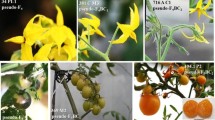Abstract
A novel host-selective phytotoxin was isolated from Alternaria solani fungus. Correlation between blighting of tomato plants and resistance of the pollen to the substance was found to be -0.75. A method for gametophyte selection was developed that produced progeny with enhanced resistance to the disease within two generations.
Similar content being viewed by others
References
Bino RJ, Hille J, Franken J (1987) Kanamycin resistance during in vitro development of pollen from transgenic tomato plants. Plant Cell Rep 6:333–336
Bino RJ, Franken J, Witsenboer HMA, Hille J, Dons JJM (1988) Effects of Alternaria alternata f. sp. lycopersici toxins in pollen. Theor Appl Genet 76:204–208
Darakov OB, Onoprienko VV (1990) Chemical diversity in closely related clones of Alternaria solani Sor. In: 4th International Mycological Congress IMC-4 (Abstracts), Regensburg, pp 321–323
De Bary A (1886) Über einige Sclerotinien und Sclerotinienkrankheiten. Bot Zeit 44:376–474
Hewitt FR, Hough T, O'Neill P, Sasse JM, Williams EG, Rowan KS (1985) Effect of brassinolide and other growth regulators on the germination and growth of pollen tubes of Prunus avium using a multiple hanging-drop assay. Aust J Plant Phys 12:201–211
Matern U, Strobel G, Shepard J (1978) Reaction to phytotoxins in a potato population derived from mesophyll protoplasts. Proc Natl Acad Sci USA 75:4935–4939
Mulcahy DL (1984) Manipulation of gametophytic populations. In: Lange W, Zeven AC, Hogenboom NG (eds) Efficiency in plant breeding. Pudoc, Wageningen, pp 167–175
Sacher R, Mulcahy DL, Staples R (1983) Developmental selection for salt tolerance during self-pollination of Lycopersicon x Solanum F1 for salt tolerance of F2. In: Mulcahy DL, Ottaviano E (eds) Pollen: biology and implications for plants breeding. Elsevier Biomedical Amsterdam New York, pp 329–334
Sari-Gorla M, Mulcahy DL, Gianfranceschi L, Ottaviano E (1988) Gametophytic selection for salt tolerance. Genet Agrar 42:92–93
Scheffer RP, Livingston RS (1984) Host-selective toxins and their role in plant diseases. Science 223:17–21
Stancheva J (1988) Assessment of tomato susceptibility to Alternaria solani by culture filtrate of the pathogen, (in Bulgarian) Rastenievodni Nauki 25:71–76
Ueno T (1990) Secondary metabolites related to host selection by plant pathogenic fungi. Pure Appl Chem 62:1347–1352
Zamir D, Gadish I (1987) Pollen selection for low temperature adaptation in tomato. Theor Appl Genet 74:545–548
Author information
Authors and Affiliations
Rights and permissions
About this article
Cite this article
Darakov, O.B. Gametophyte selection of tomatoes for resistance to early blight disease. Sexual Plant Reprod 8, 95–98 (1995). https://doi.org/10.1007/BF00230895
Received:
Accepted:
Issue Date:
DOI: https://doi.org/10.1007/BF00230895




